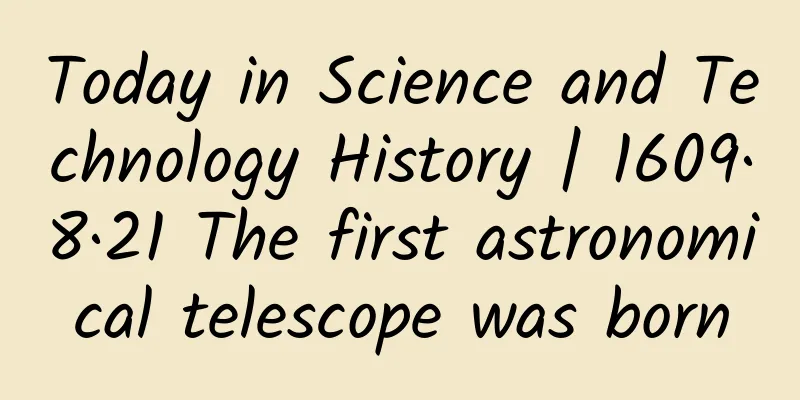Today in Science and Technology History | 1609·8·21 The first astronomical telescope was born

|
Since ancient times, human beings have never stopped exploring the distant stars. As a powerful tool for observing distant celestial bodies, the development of telescopes not only witnessed the gradual deepening of human understanding of the universe, but also reflected the brilliant progress of scientific and technological civilization. On August 21, 1609, Italian scientist Galileo invented the first astronomical telescope, which brought revolutionary changes to the development of astronomy. From the earliest optical telescope to the modern space telescope, this process not only witnessed the continuous deepening of human understanding of the universe, but also demonstrated the tremendous power of scientific and technological development. ◆The origin of the ancient telescope As early as the 4th century BC, the ancient Greek philosopher Aristotle proposed the method of using convex lenses to magnify objects, which laid the groundwork for the birth of the telescope. In 1608, a Dutch eyeglass maker Hans Lippershey first pioneered this great invention. He saw two children in front of the store looking at the weather vane on the distant church through two lenses, so he began to try it and found that when observing with two glasses, the distant weather vane was magnified a lot, so he tried to assemble the two lenses together, using a tube as a skeleton. After many experiments, he finally successfully assembled the first telescope in history. His invention is widely regarded as the origin of the modern telescope. In 1609, Italian astronomer Galileo Galilei improved the telescope. He used a convex lens instead of a concave lens and made a refracting telescope about 1.2 meters long and 4 centimeters in diameter. It can magnify objects by about 20 to 30 times, giving it a higher magnification and better imaging quality, making the observed image clearer. Galileo made about 30 telescopes in total, 10 of which were used for sky observation. He used it to scientifically observe the surface of the moon, realizing the first scientific observation of the moon by humans. After that, he carried out systematic research on the solar system with homemade equipment. Galileo made detailed descriptions of the phase changes of Venus, the four satellites of Jupiter and sunspots, and found factual basis for Copernicus's "heliocentric theory". In order to commemorate this discovery, people named the four larger satellites of Jupiter "Galilean satellites". Galileo's telescope is also considered to be the world's first astronomical telescope, which brought revolutionary changes to the development of astronomy. ◆The rise of modern telescopes In 1668, Newton made the world's first reflecting telescope, which had an aperture of 25 mm and a spherical mirror as the primary mirror. Although the performance of this telescope could not be considered good, replacing the refracting mirror with a reflecting mirror was a huge improvement. However, because the spherical aberration caused by spherical mirrors is very serious and parabolic processing is difficult, the reflecting telescope did not develop much in the 100 years after its birth. The Industrial Revolution in the 18th century brought it a guarantee of manufacturing technology. In 1773, British astronomer William Herschel made a reflecting telescope with a diameter of 1,300 mm, and used this telescope to first discover Uranus in 1781. Unlike the Newtonian telescope, this telescope, nicknamed "cannon", omits the reflecting secondary mirror. The main reflecting mirror is placed at an angle, requiring the observer to stand at the mouth of the high mirror tube and look down. Herschel personally ground more than 400 mirrors in his lifetime, recorded data on 117,600 stars, and tried to describe the structure of the Milky Way. It can be said that it was his persistence in mirror-making technology that brought mankind into the era of stellar astronomy. Entering the 20th century, reflecting telescopes ushered in their golden age. The Mount Wilson Telescope, completed in 1908, had an aperture of 1.5 meters, the Hooker Telescope, put into use in 1917, had an aperture of 2.5 meters, and the Hale Telescope, put into use in 1948, had an aperture of 5 meters. Compared with the rapid development of reflecting telescopes, refracting telescopes, as the first type of telescope, developed slowly due to the difficulty of processing large-size lenses. It was not until 1757 that the French chemist Dulong established a preliminary theory of chromatic aberration, proposed and manufactured achromatic lenses, and the refracting telescope ushered in another rapid development in history. The representative of the refracting telescope is the world's largest refracting telescope built in 1897 - the Yerkes telescope with a diameter of 1.02 meters. However, since the Yerkes telescope, the development of refracting telescopes seems to have reached its limit, because the larger and heavier the lens, the easier it is to deform from the central depression, which will affect the observation quality over time. The Golden Age of Modern Telescopes The past 40 years have been the golden age of the development of astronomical telescopes, with a wide variety of telescopes with different functions being put into use. Today, telescopes have broken through the barriers of the visible light band and are moving towards full-band observations. From the gamma-ray band "Wukong", to the ground-based telescope Keck and the space-based telescope Hubble in the visible and near-infrared bands, to the "Sky Eye" (FAST) in the radio band. At the same time, the functions of telescopes have also been greatly enriched, and are no longer limited to the image photography analysis of the past. Modern visible light and near-infrared telescopes are mainly divided into three categories in terms of function. The first category is general-purpose telescopes represented by the 8.2-meter-diameter Very Large Telescope, the second category is large-scale imaging survey telescopes represented by the 8.4-meter-diameter Large Synoptic Survey Telescope (LSST), and the third category is spectral survey telescopes represented by the 4-meter-diameter Guo Shoujing Telescope (LAMOST). Many modern telescopes have provided us with valuable observational data, greatly promoting the development of astronomy, cosmology and physics. Several of these telescopes are milestones in the history of scientific development. The Palomar-Hale Telescope is the world's first modern scientific telescope with an aperture of more than 3 meters. It was built in 1930 and completed in 1948. Its data helped people solve the mystery of the production of heavy elements. It is still in working condition. The Sloan Digital Sky Survey Telescope is currently the telescope project with the richest scientific output in the world. It was built in 1986 and completed in 1998. Although the telescope has an aperture of only 2.5 meters, its data has generated nearly 9,000 papers with a total of more than 470,000 citations. It is still producing rich data for astronomers to explore the mysteries of the universe. The Hubble Space Telescope is the first space astronomical telescope in human history. It breaks through the atmospheric barrier to observation and raises the resolution of human telescopes to the diffraction limit for the first time, greatly enriching human understanding of the universe. On April 24, 1990, the Hubble Space Telescope was launched with the Space Shuttle Discovery and then entered an orbit 600 kilometers above the earth. The optical part of the Hubble Space Telescope adopts a Cassegrain reflection system, which consists of two hyperbolic mirrors, with a primary mirror diameter of 2.4 meters and a secondary mirror diameter of 0.4 meters. The light is reflected from the primary mirror to the secondary mirror, and then to the central hole of the primary mirror to form an image on the focal plane of the primary mirror. After being processed by precision instruments, the data is sent back to the ground via a relay satellite. Without the interference of the atmosphere, Hubble can observe 7 times the distance of the most powerful ground-based Hale Telescope, detect 350 times the universe, and the image clarity can reach 10 times that of ground-based observations. The images of the ultra-deep space field sent back to the Earth by the Hubble Telescope have helped solve many basic problems that have long plagued astronomers, including the calculation of the Hubble constant and the determination of the age of the universe as 13.7 billion years. Comprehensive from "Huazhong Astronomy", "Observing the Sky Giant Eye", Guangming.com |
>>: The Perseid meteor shower "blooms" in the night sky! You may not think how it is formed...
Recommend
The first batch of scientific results of the space new technology experimental satellite
On September 5, the reporter learned from the Chi...
Android Q lets users manage location permissions elegantly
[[262144]] Apps can use location data to bring An...
Without the traffic from NetEase and Alipay, how can ordinary products spread themselves and go viral?
There are unknown secrets behind every screen-swe...
iMessage's Emoji bug has existed for multiple versions
Recently, Apple iOS has been exposed to various b...
Google may release Android 5.0, Nexus 6 and Nexus 9 today
Earlier today, foreign media Forbes reported that...
Apple Pay is not mature: 80% of iPhone 6 users in the US do not use it
[[129069]] According to a survey of 1,000 iPhone ...
Asian Winter Science Popularization Issue 2丨Speed skating VS short track speed skating, what is the difference?
Asian Winter Science Popularization Episode 2丨A D...
How to make steady progress when launching an APP?
That’s the title , but if you ask me how I got 1 ...
Did the moon fall really happen?
There is a disaster movie called "Moonfall&q...
14 cases, summarizing 6 growth strategies!
I did an activity called " 7-week growth cas...
The "Four Great Inventions of Chinese Agriculture" that You Don't Know Have Been Popularized Around the World for Thousands of Years
Silk, rice, tea and soybeans are known as the fou...
How to pick blueberries? First, you need a "big comb"
Have you ever seen blueberries picked like this? ...
To do a good job of through train promotion, we need to simplify the cumbersome
Almost all real sellers have used Through Train. ...
Xiao Wu 21 days to gain high-quality parent-child relationship decryption "Unconditional Parenting" Parenting course audio + document
Xiao Wu's 21-day high-quality parent-child re...
The fourth session of the Aiti Tribe Technical Clinic
【51CTO.com original article】 [51CTO original arti...









